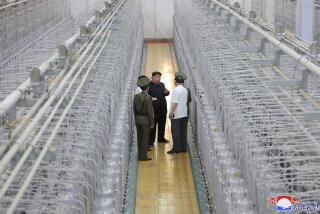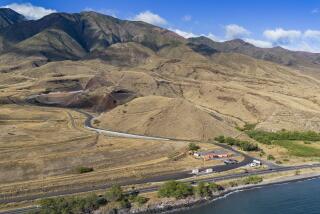Ship Carrying Tons of Nuclear Waste Barred From Small Japanese Port
- Share via
TOKYO — In a gesture of defiance that bodes ill for Japan’s beleaguered plutonium program, the governor of Aomori prefecture Tuesday refused to allow a British ship carrying 30 tons of high-level nuclear waste to dock in northeastern Japan.
The Pacific Swan was still riding the waves today about 2 1/2 miles offshore. On Tuesday, local farmers and antinuclear activists staged a sit-in to block the port of Mutsu-Ogawara in Rokkasho, and Prime Minister Ryutaro Hashimoto refused to yield to demands that he meet with Aomori Gov. Morio Kimura to discuss finding a permanent resting place for the plutonium-rich radioactive waste.
Kimura charges that the central government has done next to nothing to fulfill a 1995 promise to create a permanent site to which high-level waste could be moved--other than promising that an unspecified alternative dump will be selected by 2020. He wants a site chosen by 2000, reflecting local fears that the longer Rokkasho plays temporary host to waste, the more likely it is to be stuck with the stuff forever.
“We are afraid of an accident, of course, and if it happened, who would take responsibility? No one,” said Yumiko Oshita, a longtime foe of the nuclear waste storage facility in Rokkasho, a tiny town in the remote northeast. “If we don’t say no, they will just continue to make more and more waste.”
Japan, which consumes 10% of the world’s oil, relies on nuclear power for 33% of its energy. But opposition to its nuclear policies--particularly its plutonium energy program--has intensified since 1995. That year, an accident forced the shutdown of a prototype plutonium reactor at Monju, and Japan began sending waste from conventional nuclear power plants to Britain and France to be reprocessed, then returned.
Rokkasho and its neighbors on the Shimokita peninsula had already become a nuclear alley, with four power plants, a uranium-enrichment plant, a low-level radioactive waste dump and plans to build a plutonium reprocessing plant, among other facilities--all in exchange for huge government compensation payments and a public works bonanza that has boosted the moribund local economy.
Rokkasho is expected to be the site to store reprocessed high-level waste for 30 to 50 years. Where the waste ultimately will wind up is unclear. But much of the plutonium could be consumed as fuel for the Monju fast-breeder reactor, if it was to overcome fierce local opposition and reopen.
But when the first ship bearing reprocessed, high-level waste arrived after a protest-plagued voyage from Europe in 1995, Kimura refused to let it dock until the central government promised that a permanent site for the waste would be found.
When the 28 glass canisters containing reprocessed waste from Cap de la Hague in France were unloaded and examined, the radioactive contaminant cesium was found on the outside of one container, raising fears of leakage. Activist Oshita asserted that Nippon Gennen, the company responsible for storage, tried to cover up the problem.
A company spokesman insisted that the canisters and their storage facilities are safe. The cesium “was just like some dust that had landed on the outside,” Gennen spokesman Yukio Ichikawa said Tuesday. “It was not a leak, and there was not a problem.”
Others have doubts. A 1996 report by Edwin S. Lyman, scientific director of the Washington-based Nuclear Control Institute, concluded that arguments supporting the conclusion that the canister had not leaked were “faulty.” Lyman recommended that Kimura refuse further shipments pending a peer-reviewed investigation of “the integrity of the canisters.”
“Over a long period of time, the glass might--well, this isn’t a scientific term, but it could ‘melt,’ ” Oshita said. “The assumption--and it is just an assumption--is that it will last 40 or 50 years, but that depends on the radiation level of what’s inside.”
Despite the opposition, Kimura let a second ship unload its cargo in 1997. And activists said he did not publicly protest the arrival of the current ship until it appeared on the horizon off Rokkasho, though the Pacific Swan sailed from the Panama Canal last month. Its passage was reported by Japanese media because it was the first of the waste ships allowed to use the canal and was boarded by four antinuclear protesters as it passed through.
Hashimoto told reporters Tuesday that the minister of science and technology and the minister of trade and industry had been meeting with Kimura to try to resolve the conflict.
Greenpeace Japan called for an immediate halt to the reprocessing of Japan’s “dangerous” plutonium waste in Europe, which would also “halt the astronomical growth of Japan’s stockpile of weapon-usable plutonium.” Japan has 4 1/2 tons of plutonium waste at home and 15 tons more being processed in Britain and France, Greenpeace activist Hideaki Takemura said.
It was unclear how long the standoff might continue. But local activists were not optimistic that the governor’s protest will change policy from Tokyo, which will probably meet fierce opposition from any community where it tries to place a high-level waste dump. Since 1996, three Japanese towns have held nonbinding referendums to reject nuclear power plants or industrial waste dumps backed by the central government.
More to Read
Sign up for Essential California
The most important California stories and recommendations in your inbox every morning.
You may occasionally receive promotional content from the Los Angeles Times.








